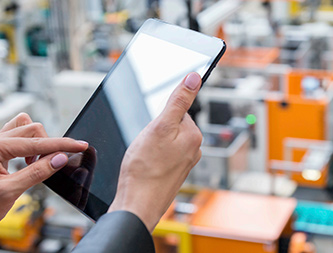- Home
- Business Knowledge Center
- Wi-Fi 6 vs 5G
WI-FI 6 vs. 5G: Defining the Right Solution for Your Business
5G. Wi-Fi 6. 4G LTE. So many numbers, so many acronyms, so much confusion. How do you differentiate between all these wireless technologies?

This article will break things down for you by:
- Explaining the differences between Wi-Fi 6 and 5G
- Exploring how each can be applied in different business environments
- Briefly highlighting their impact on IoT, and
- Providing guidance on which technology is right for your business
Differences
Defining the differences: Wi-Fi 6 vs. 5G

-
You’ve heard about 5G, but do you know what it can do for your business? You can learn more about it here, but in brief, 5G is the name given to the fifth generation of wireless cellular technology.
5G operates on several spectrums: 600MHz, 2.5GHz, 28GHz and 39GHz. 5G cell towers are typically smaller than 4G cell towers, require less power to operate, and are capable of serving more users than ever before.
5G’s most notable features include increased bandwidth, faster download speeds, and lower latency. While download speed is undoubtedly important, the lower latency stands out as a key driver for 5G applications.
Latency represents the delay in sending data from one point to another and is typically measured in milliseconds. The numbers are impressive: with 4G, latency often reaches 50ms, whereas 5G is capable of 1 ms.
A VoIP phone service is practical because it allows people to make calls that may not have access to a landline or cell phone or because they are outside of an area covered by traditional telephone service.

-
5G’s speed, bandwidth and low latency open the door for endless mobile applications across every business industry.
Wi-Fi 6, on the other hand, is the latest technology for the Wi-Fi designation, which uses an unlicensed spectrum for anyone to use. Wi-Fi is now ubiquitous and can be found in almost any location you visit. We rely on Wi-Fi at home, in the office, retail locations, and more.
The most common form of Wi-Fi is 5GHz, which often causes confusion with 5G; they’re not the same. So, the Wi-Fi Alliance has set a new standard, 802.11ax, which is commonly known as Wi-Fi 6. Wi-Fi 6 delivers speeds approximately four times as fast as Wi-Fi 5, but also boasts capacity and efficiency improvements.
Much like 5G complements 4G for mobile, Wi-Fi 6 compliments Wi-Fi 5 standards.
Opportunities
Complementary solutions that expand opportunities across industries and environments

-
Remember, when evaluating 5G and Wi-Fi 6 for your business, it’s not a case of one or the other. Typically, most organizations will benefit from leveraging both technologies, since Wi-Fi 6 and 5G complement each other as well.
For today’s remote and hybrid work environments, both technologies support a myriad of applications and solutions. Depending on the use case or application, they each have their strengths and can work together for optimal efficiency.
Without getting into the technical requirements of specific applications, it’s probably safe to say that Wi-Fi will serve on-premise devices while 5G will serve mobile devices.
Especially with its much longer range, 5G will be used for applications where a Wi-Fi access point is not nearby.
Typically, you’ll want to deploy 5G when you require a reliable and low latency connection, cover a vast geographical area, deploy widespread endpoints, and need more accuracy and precision.
Some examples of 5G deployments include connected cars, manufacturing environments, intelligent fleets, smart cities and utilities, and remote healthcare monitoring.
AT&T Business Wi-Fi
Manage Wi-Fi® across your locations like never before. Deliver the highly reliable wireless experience guests expect. And keep your back office connected and your data highly secure.

IoT
Wi-Fi 6 and 5G for business growth: Internet of Things (IoT)

-
The Internet of Things (IoT) refers to physical devices that typically are not computing devices but can connect to the internet to transmit and receive data. Cameras, fridges, and smart speakers may come to mind, but almost every industry uses some sort of IoT device to improve business efficiency. For today’s modern organization, IoT provides access to critical data or applications that can be used to help make better business decisions.
This means is that IoT is about much more than allowing more devices and applications and expanding use cases. IoT empowers businesses to grow and scale by leveraging data. With more data to analyze, businesses gain valuable insight into their processes and systems, providing opportunities for innovation and growth. IoT can help companies create new lines of business, improve customer experience, and achieve greater efficiency.
The business benefits of leveraging IoT are almost endless, and you can learn much more about IoT here.
What's faster
Is Wi-Fi 6 faster than 5G?

-
Basically, yes, Wi-Fi 6 is faster than 5G. While 5G’s speed will often be greater than 1 Gbps, Wifi 6 speeds can theoretically achieve 9.6 Gbps.
But businesses should not be basing their decisions on speed alone, as both technologies are faster than their predecessors, and both are very fast.
Again, it all boils down to the What, Where and Why of your business requirements.
VoIP with IoT
VoIP Interaction with IoT Solutions

-
Internet of things (IoT) and VoIP are a perfect match, as they both rely on IP communications to interact. Like AI, the best way to demonstrate how VoIP and IoT solutions can integrate is with practical use cases.
Imagine a smart home or office where you can call in and manage appliances or heating systems using only your voice — even if you don’t have internet access.
Or what about an IoT sensor installed on the factory floor? That sensor can make a VoIP call to relevant stakeholders who need to be updated on what’s happening for safety, productivity, or efficiency concerns.
What's better
What’s better for your business?

-
When it comes to providing wireless connectivity for your business, 5G and Wi-Fi should not be seen as competing technologies. The likelihood of either technology taking over the business world is minimal, as we’ve already established that 5G and Wi-Fi 6 are complementary technologies. For best business results, you’ll need to find the right balance of both and know which operational scenarios are best suited to each.
As a rule of thumb, business users would use Wi-Fi 6 from their desk and 5G in the field.
Ultimately, finding the right solution for your business can be challenging. But with AT&T Business, you’ll get all the help and resources you need to get the most out of both 5G and Business Wi-Fi so you can begin or improve your digital transformation journey.
There are many benefits to moving VoIP services to the cloud. For one, businesses can take advantage of economies of scale, getting more bang for their buck by leveraging the pooled resources of a larger pool of users. In addition, businesses can enjoy greater flexibility and scalability, quickly adding or subtracting users as needed and scaling up or down as traffic ebbs and flows.
Businesses can also take advantage of security measures that are built into SaaS platforms. These platforms offer a number of security layers designed to protect against many types of attacks.
VoIP Services with AT&T Business
From basic phone services to advanced cloud-based “as a service” voice solutions, AT&T Business has got you covered
with a wide range of VoIP phone services and products tailored specifically to your business.
- Terms of use
- Your privacy center
- Accessibility
- Your Privacy Choices
- Health Privacy Notice
- Cyber Security
© AT&T Intellectual Property. All rights reserved. AT&T, the AT&T logo and all other AT&T marks contained herein are trademarks of AT&T intellectual property and/or AT&T affiliated companies. All other marks are the property of their respective owners.